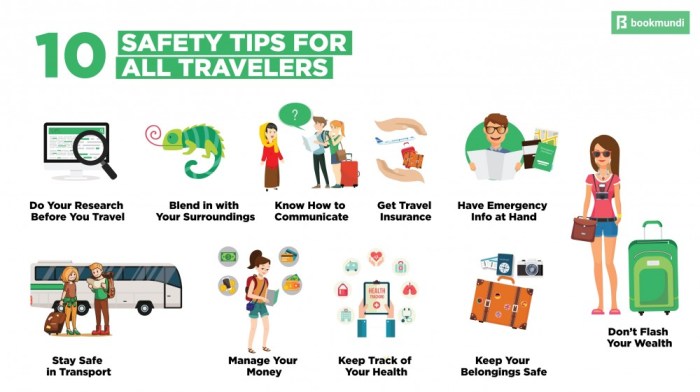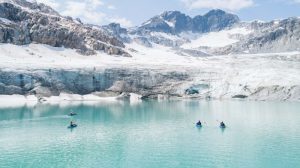
Group travel safety tips are paramount for a successful and enjoyable trip. Planning a group adventure involves coordinating multiple individuals, itineraries, and potential risks. This guide provides comprehensive advice, covering pre-trip planning, transportation safety, accommodation security, health precautions, communication strategies, budgeting, and various modes of travel, ensuring a smoother and safer experience for everyone involved. From navigating unfamiliar transportation systems to managing group finances and handling emergencies, we’ll equip you with the knowledge to confidently tackle any challenges that may arise.
Understanding the unique safety considerations for different travel methods—be it air, train, cruise, road trip, or unique accommodations like treehouses or houseboats—is crucial. We’ll explore practical strategies for minimizing risks and maximizing enjoyment, offering actionable steps to create a memorable and secure group journey. We’ll also cover essential topics such as securing your belongings, managing health emergencies, and building effective communication channels to keep everyone informed and safe throughout the trip.
RV and Camper Travel (Safety Focused)
Embarking on an RV or camper trip offers unparalleled freedom and adventure, but prioritizing safety is paramount. This section details crucial pre-trip checks, safe driving and parking techniques, emergency preparedness, and securing your belongings to ensure a worry-free journey. Careful planning and attention to detail can significantly mitigate potential risks and enhance your overall travel experience.
Pre-Trip Safety Checks for RVs and Campers
Before setting off, a thorough inspection of your RV or camper is essential. This involves checking tire pressure and tread depth, ensuring proper functioning of brakes and lights, verifying fluid levels (engine oil, coolant, transmission fluid), and inspecting the propane system for leaks. A visual examination of the exterior for any damage or loose components is also crucial. Inside, test all appliances (refrigerator, stove, air conditioning) and ensure the water system is clean and functional.
Finally, familiarize yourself with the location of emergency equipment, including fire extinguishers, first-aid kit, and spare tire. A pre-trip checklist can be invaluable in ensuring nothing is overlooked.
Safe Driving and Parking Practices with RVs and Campers
Driving an RV or camper requires different skills and considerations than driving a car. Due to their larger size and weight, these vehicles require more space for maneuvering and braking. Plan your routes carefully, avoiding narrow roads or steep inclines whenever possible. Maintain a slower speed than you would in a car and allow extra distance between your vehicle and others.
When parking, choose level and stable surfaces, ensuring adequate space for opening doors and extending awnings. Be mindful of overhanging branches and low-hanging objects. Consider using leveling blocks to stabilize the vehicle on uneven ground. Remember that backing up an RV or camper requires extra caution and often assistance from a spotter.
Handling Emergencies While Traveling in an RV or Camper
Emergencies can arise unexpectedly. Having a well-stocked first-aid kit is crucial, along with a comprehensive emergency plan. This should include knowing how to contact roadside assistance, having a plan for communication in case of cell service loss, and understanding basic vehicle maintenance procedures. In the event of a breakdown, secure the vehicle safely, turn on hazard lights, and place warning triangles behind the vehicle.
If involved in an accident, contact emergency services immediately and follow all instructions from law enforcement. Knowing your route and having a backup plan for lodging in case of unexpected delays is also recommended.
Ensuring the Safety and Security of Belongings in an RV or Camper
Protecting your belongings is paramount. Install a reliable alarm system and consider using locking devices on storage compartments and windows. While traveling, keep valuables out of sight and secure important documents in a fireproof safe. When parked at campsites, be aware of your surroundings and lock all doors and windows. Avoid leaving valuable items unattended, and if possible, use a wheel chock for added security.
Consider purchasing a GPS tracker for added peace of mind. Inform someone of your travel itinerary and expected return date.
Unique Stays and Treehouses (Safety Considerations)

Staying in unique accommodations like treehouses offers a memorable travel experience, but it’s crucial to prioritize safety. These lodgings often present different challenges than traditional hotels or vacation rentals, requiring a more cautious approach to ensure a pleasant and hazard-free trip. Understanding potential risks and taking proactive steps can significantly reduce the likelihood of accidents or incidents.Choosing a safe and well-maintained unique stay requires careful consideration and research.
While the allure of these unusual accommodations is undeniable, it’s essential to balance the appeal with a thorough assessment of potential safety concerns. This includes verifying the property’s safety features, reading reviews from previous guests, and directly communicating with the host to address any uncertainties.
Potential Safety Hazards in Unique Accommodations
Unique accommodations, particularly treehouses, present a range of potential hazards. These can be broadly categorized into structural issues, environmental risks, and access challenges. A comprehensive understanding of these hazards allows for informed decision-making and preventative measures.Examples of structural hazards include unstable structures, inadequate railings or guardrails, and poorly maintained ladders or stairs. Environmental hazards may involve the presence of wildlife, the risk of falling branches, or exposure to the elements, particularly during inclement weather.
Access to the accommodation can also pose challenges, such as navigating uneven terrain or traversing precarious pathways. For instance, a poorly lit path leading to a treehouse at night could increase the risk of a fall.
Choosing Safe and Well-Maintained Unique Stays
Before booking, thoroughly research the accommodation. Look for high-quality photos and videos showcasing the structure’s stability and safety features. Read recent guest reviews, paying close attention to comments regarding safety concerns. Check for certifications or licenses indicating compliance with relevant safety standards. Websites specializing in unique accommodations often provide detailed information and reviews, helping you make an informed decision.
Communicating Safety Concerns to Hosts
Open communication with the host is paramount. If you have any concerns about safety features or potential hazards, don’t hesitate to contact the host directly before your stay. Clearly articulate your concerns and ask for clarification or reassurance. For instance, if you notice in the photos that a railing seems flimsy, ask the host about its sturdiness and recent maintenance.
A responsive and transparent host will address your concerns promptly and provide necessary information to alleviate your worries. If your concerns remain unaddressed, consider choosing alternative accommodation.
Houseboat and Yacht Stays (Safety Considerations): Group Travel Safety Tips

Houseboat and yacht vacations offer unique experiences, but safety should always be the top priority. These floating accommodations present a different set of challenges compared to land-based lodging, requiring awareness of specific hazards and adherence to safety protocols. Understanding the inherent risks and taking proactive measures is crucial for a safe and enjoyable trip.
Safety Equipment on Houseboats and Yachts
Houseboats and yachts, depending on their size and the regulations of their operating area, are typically equipped with a range of safety features. These features are designed to mitigate risks associated with water travel and ensure the safety of occupants. Essential equipment may include life jackets (personal flotation devices or PFDs) for each person on board, along with throwable flotation devices.
Fire extinguishers, appropriate for marine environments, are usually present, along with a first-aid kit stocked with supplies relevant to water-related injuries. Navigation equipment such as GPS, charts, and radios (VHF) aids in safe navigation and communication in case of emergencies. Bilge pumps are crucial for removing water that may accumulate in the hull. Other potentially included safety equipment may include flares, a horn, and emergency lighting.
The specific equipment present will vary depending on the vessel’s size, age, and the regulations governing its operation.
Staying Safe on a Houseboat or Yacht, Group travel safety tips
Safe practices are paramount for enjoying a houseboat or yacht vacation. Before embarking, passengers should receive a thorough safety briefing from the rental company or owner, covering the location of safety equipment, emergency procedures, and the vessel’s operating characteristics. It is crucial to always wear a life jacket when on deck or in the water, especially at night or in rough conditions.
Never operate the vessel under the influence of alcohol or drugs. Familiarize yourself with the boat’s navigation systems and emergency communication procedures. Regularly check weather forecasts and adjust plans accordingly, avoiding travel in severe weather. Maintain constant awareness of the surroundings, paying attention to other vessels, navigation hazards, and changing weather conditions. Be mindful of potential hazards such as strong currents, shallow waters, and other watercraft.
In the event of an emergency, calmly follow the established procedures, using the appropriate communication channels to contact emergency services.
Potential Safety Hazards
Several potential hazards exist during houseboat and yacht stays. Carbon monoxide poisoning is a significant risk, particularly on older or poorly maintained vessels. Proper ventilation is crucial to prevent the buildup of this deadly gas. Falls overboard are a common occurrence, highlighting the importance of handrails, life jackets, and constant vigilance. Fire is another major concern; it can spread rapidly in a confined space.
Proper maintenance of the vessel’s systems and adherence to fire safety guidelines are essential. Mechanical failures, such as engine trouble or steering malfunctions, can lead to dangerous situations. Regular maintenance and inspections are vital. Exposure to the elements, such as extreme heat or cold, can also pose risks, requiring appropriate clothing and preparedness. Lastly, collisions with other vessels or objects are a significant danger, emphasizing the need for careful navigation and adherence to boating regulations.
Verifying Houseboat and Yacht Seaworthiness
Before booking a houseboat or yacht, it is essential to verify its safety and seaworthiness. Thoroughly inspect the vessel for any signs of damage or disrepair. Check the condition of safety equipment, ensuring it is functional and up-to-date. Request documentation showing recent maintenance and inspections, including engine servicing and safety checks. Read reviews from previous renters to gain insights into the vessel’s condition and the rental company’s reliability.
If possible, contact previous renters directly to ask specific questions about their experience. Don’t hesitate to ask the rental company for clarification on any safety concerns. Inquire about the vessel’s insurance coverage and the procedures in case of an accident or emergency. A thorough due diligence process will significantly enhance your safety and peace of mind during your houseboat or yacht vacation.
Safe and successful group travel hinges on meticulous planning and proactive risk management. By implementing the safety tips Artikeld in this guide, you can significantly reduce potential hazards and enhance the overall experience for all participants. Remember, thorough preparation, clear communication, and a focus on preventative measures are key to ensuring a worry-free and memorable group adventure. From pre-trip checklists to emergency procedures, a proactive approach transforms potential problems into manageable situations, allowing you to focus on enjoying the journey with your companions.
FAQ Explained
What should I do if someone in my group gets lost?
Immediately contact your designated group leader. Have a pre-arranged meeting point and establish a regular check-in system. Notify local authorities if necessary.
How can I protect my valuables during group travel?
Use secure luggage with locks, avoid displaying expensive jewelry, distribute valuables among group members, utilize hotel safes, and be mindful of your surroundings.
What are some signs of a potentially unsafe accommodation?
Look for poor lighting, lack of security measures (e.g., no locks, security cameras), questionable reviews mentioning safety concerns, and isolated locations.
What if I have a medical emergency while traveling?
Contact your travel insurance provider, local emergency services, and your designated group leader immediately. Carry a copy of your medical information and any necessary prescriptions.
How do I handle a disagreement within the group?
Address conflicts calmly and respectfully. Try to find a compromise. If the disagreement escalates, consider involving a neutral third party (e.g., tour guide) to mediate.





